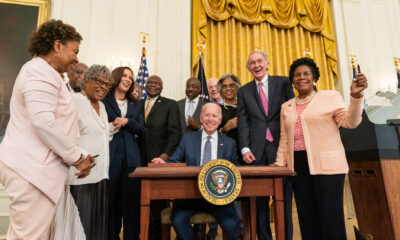Black History
How Busing Has Been Used As A Distraction From The Real Issue: School Integration

Many Americans are familiar with the Brown v. Board of Education Supreme Court ruling which declared “separate but equal” unconstitutional, opening the door for school integration. But a less known case critical to integrating America’s schools was upheld 50 years ago: Swann v. Charlotte-Mecklenburg.
Swann v. Charlotte-Mecklenburg unanimously upheld busing programs that aimed to speed up the racial integration of public schools in the country. Years after the Brown decision in 1954 schools were still largely segregated due to the lack of integration in America’s neighborhoods.
In most cities, parents resisted integration. Charlotte, North Carolina was one of the more moderate Southern cities and had sought to integrate its schools with a school assignment plan based on neighborhoods which the Court approved. But when Charlotte consolidated with an area outside of the city, schools were still largely segregated because African American students lived in the central city and white students lived farther from the city.
Is busing a fake issue?
The NAACP Legal Defense Fund filed the case on behalf of six-year-old James Swann and nine other families. Swann’s father was a theology professor, and it was believed he would be affected less by local retaliation.
Charlotte-Mecklenburg Board of Education won in the lower court, the ruling declaring that the Constitution did not require purposeful racial mixing. But on appeal to the federal bench, Judge James McMillian, a public opponent of busing, ruled in favor of Swann, stating that facts overrode feelings. When the case went to the Supreme Court, Chief Justice Warren Burger wrote a convoluted opinion but ultimately sided with Swann. The decision led to the use of busing as the way to end segregated schools.
The debate around busing was not confined to the South. As Vice-President Kamala Harris famously pointed out during a Democratic presidential debate in 2019, she was “that little girl” who was part of the Berkeley, California Public Schools’ busing integration plan in the 1960s.
As white parents in all geographic areas protested busing, some legal scholars and integration proponents saw their opposition as a thinly veiled endorsement of racism and racial segregation.
Recently, Matthew Delmont from the Brookings Institution wrote the book, Why Busing Failed. Delmont described “busing” as a fake issue. He wrote, “Rather than starting the story in the 1970s, we need to understand that the battles over “busing” started two decades earlier in the wake of the Brown decision and in the context of civil rights activism in the North … And rather than using “busing” as a politically neutral word, we need to understand that this term developed as a selective way to label and oppose school desegregation.”

-

 Featured10 months ago
Featured10 months agoCalifornia Is the First State to Create A Public Alert for Missing Black Youth
-

 Featured10 months ago
Featured10 months agoAfrican American Leaders Stay the Course Amid Calls for President Biden To Bow Out of Race
-

 Featured10 months ago
Featured10 months agoThe Debate Fallout Lands on Both Candidates
-

 Featured9 months ago
Featured9 months agoPresident Joe Biden Decides to Withdraw from the Presidential Race
-

 Featured9 months ago
Featured9 months agoIn One of His Final Speeches as President, Biden Says It’s Time for ‘Fresh Voices’
-

 Featured10 months ago
Featured10 months agoPresident Joe Biden Describes Shooting of Donald Trump As ‘Sick’

